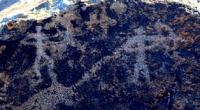Вы здесь
Petroglyphs of Kalchoku.

Batken and Central Asia on Great Silk Road.
“People usually feel funny, smile and laugh when I tell them
about my strong belief in the very existence of prehistoric
advanced technology and great civilizations of wilier races.
I just can't wait to see their faces at time the truth is revealed”
Toba Beta.
Kyrgyzstan section of the Silk Road.
Sites in this part of the valley, related to the adyr and foothill area of the Turkestan and Alay Ranges, are mainly located at an altitude of 1,500m and some higher. The earliest information about petroglyphs dates to the pre-revolution period (Veber 1914: 130).
The best known are in the Surottu Gorge and near the Okhna village (now Orozbekovo village) studied in 1939 by Voronets M.E. (1950: 75 - 90). Some petroglyphs near Okhna were examined in the early 1970’s by Shatskiy G.V., who dated them to the 1st millennium BC (1973: 16 - 18).
In 1966 - 1967, Kabyrov Zh. discovered new petroglyph locations on the southern slope of Kartan-Too near settlements Sur, Bel, Taryk, Bagyshym as well as gorge Shorbulaksay (Khujanazarov 1995: 13) and dated them to the VIIth BC – VIIIth AD centuries.
In 1979 - 1982, Kartan-Too petroglyphs were examined in the border areas of Uzbekistan and Kyrgyzstan. At the same time, new sites –drawings made with pink paintwere found near the Eshme village and petroglyphs at Zhany-Aryksay as well as previously unknown drawings at Surottu (Khujanazarov 2004: 110).
All listed locations are on different slopes of low limestone mountains. The western tip of Katran-Too reaches the Sokh enclave of Uzbekistan. Petroglyphs of Kalchoku the site is located on the territory of the Orozbekovo village (former Okhna) in Uchkun Gorge, 5km southwest of the district capital of the Kadamzhay district of the Batken Province, not far from the junction of Kadamzhay-Ayderken (Haydarken) and Kadamzhay-Kyzyl-Bulak roads.
It was discovered in 2005 by associates of the Institute of Social Sciences of the Southern Department of NAS of the RK and OshSU (Maltaev et al. 2005: 219 - 223). Many cultic items in the form of cupules, footprints, grooves in combination with few petroglyphs (about 20) with quite remarkable images were found on rock faces, individual blocks and boulders on Kalchoky Mountain and around it.
A “sun-headed” personage is carved on one of the faces of a large stone. Its facial details are thoroughly dotted and its body has four arms.
On another one, an ox-Bos primigenius in a bitriangonal style is harnessed to a two-wheeled cart steered by a waggoner. The other petroglyphs are mainly representations of mountain goats drawn in different manners. According to researchers, Sulayman-Too drawings are analogos to these petroglyphs; the site is interpreted as an ancient sanctuary.
Dating is suggested between the Late Bronze Age and the Middle Ages. Current Status and Protection. Locations at Okhna (Orozbekovo), Surottu and Suuk-Dangi are in the “Government List of Historical and Cultural Sites of National Significance”.
The sites in this district having a great scientific interest and cultural importance are potential sites for a transboundary serial nomination, which calls for a need to organize and conduct additional research, protection and management efforts.
Preliminary Comparative Analysis of the Fergana Sites The following table presents an attempt to compare the main natural, historical and cultural features of the two identified groups of rock art sites located in the high and low mountains of the Fergana (Rogozhinsky 2006).
Authority:
«Rock Art in Kyrgyzstan». Bakyt Amanbaeva, Aiday Suleymanova, Chynarbek Zholdoshev.







